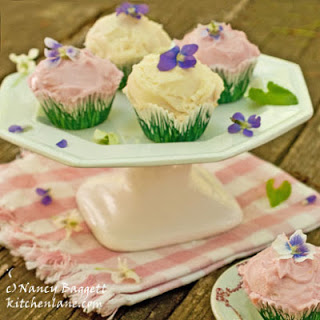 It was fated, I suppose. The very day I mentioned on Facebook that I was thinking about ways to minimize the use of commercial dyes and food colorings in my pastry decorating, I spied a bright carpet of wild purple violets along the wooded trails behind my house.
It was fated, I suppose. The very day I mentioned on Facebook that I was thinking about ways to minimize the use of commercial dyes and food colorings in my pastry decorating, I spied a bright carpet of wild purple violets along the wooded trails behind my house.About a week later, I also found some yellow and pale lavender violets in the woods–yes, they are native here in central Maryland, as well!
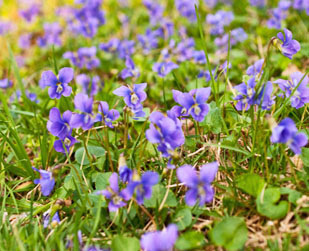 The violets along the woodland paths reminded me that years before I’d successfully used both fresh and candied violets to dress up a cake for a “Victorian-themed” tea. So, I decided to once again harvest some and take advantage their natural beauty to decorate the frosted cupcakes here while they were here at hand. Gardeners call these and similar woodland flowers “ephemerals,” because they make a brief, but dazzling appearance each spring, and then just as quickly disappear.
The violets along the woodland paths reminded me that years before I’d successfully used both fresh and candied violets to dress up a cake for a “Victorian-themed” tea. So, I decided to once again harvest some and take advantage their natural beauty to decorate the frosted cupcakes here while they were here at hand. Gardeners call these and similar woodland flowers “ephemerals,” because they make a brief, but dazzling appearance each spring, and then just as quickly disappear.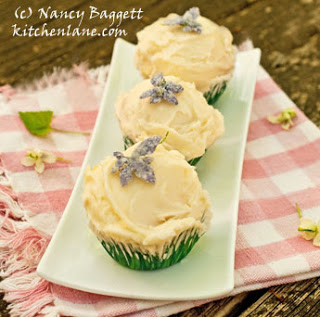
Unlike many wild and cultivated flowers, violets and their cousins, Johnny-jump-ups and pansies, are edible, so if carefully washed, they can adorn food without any health concerns. They are also tender and have a very mild, indistinct flavor, and, when candied, taste like little more than sugar. Don’t ever use unfamiliar flowers to enhance your dishes, as some are highly poisonous or taste very bitter. (Also, note that African violets are not the same as woodland violets and cannot be used.)
If placed in water, fresh purple violet blooms will hold their vibrant color and delicate shape for several days. But once perched on a cake or cupcakes or cookies, they must be served promptly as they will droop and fade in less than an hour. So, if using them fresh, plan accordingly. (Note that yellow violets are very fragile and droop right away, so aren’t really suitable for decorating unless you want to strew them on a fresh salad soon after you pick them.)
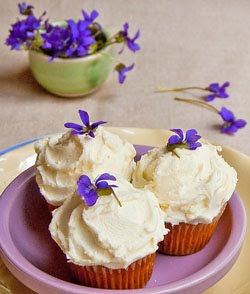
Once they are washed and patted dry, it’s possible to preserve, or “candy,” violets or their kin so they can be held and used like regular pastry decorations (as shown at left and at the top). This involves simply coating the petals on both sides with egg white, then sprinkling them evenly with superfine granulated sugar. (This can be made by grinding regular sugar in a processor until very fine.) I dip each flower into the egg white very lightly on both sides, then use a small paint brush to cover any spots missed. Then, I use a spoon to scoop sugar on one side and then another.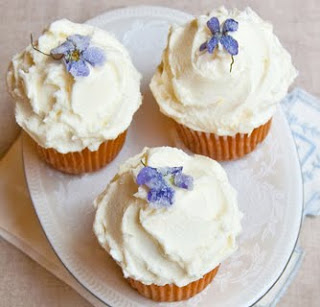
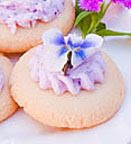 For the fresh, all-natural dye-free buttercream frostings used on the cupcakes presented above, go here.
For the fresh, all-natural dye-free buttercream frostings used on the cupcakes presented above, go here.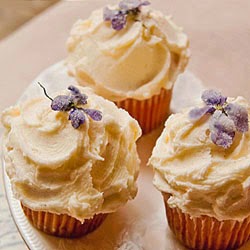
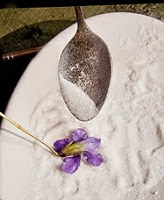
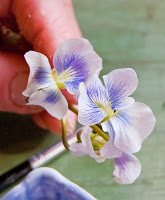
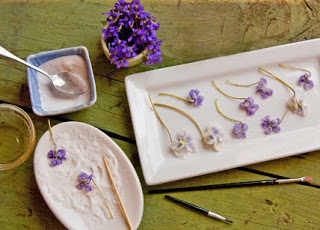

I try to buy pansies at least 6 weeks in advance of when I want to use them for food garnishing. I also wash them thoroughly by submerging them under barely warm running water 3 or 4 times. I use a lot of water, then pat them completely dry. However, I really recommend using pansies purchased from an organic grower or ones I grow to avoid any risk.
Can u please tell me is there a method to wash off pesticides on pansy flowers? I am using them to decorate a cake.
Just beautiful! I have always been intrigued by fresh flowers as decoration and as food but have never tried it! And love the candying method! Wonderful lesson, Nancy!
I'm going to skip the tea, but will be giving some of these cupcakes to my grandchildren for Easter.
What a wonderful reminder that Spring is really coming! I think they might be especially nice for a child's Tea Party.
So pretty–great idea!